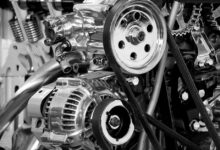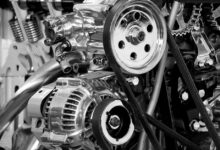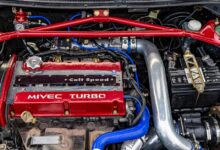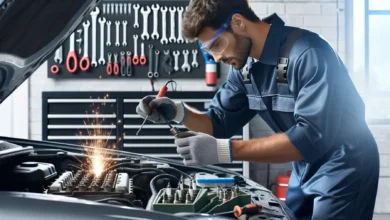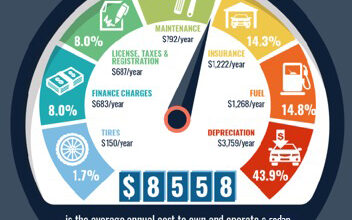Engine Diagnostics: How to Identify, Troubleshoot, and Fix Car Problems Like a Pro
Sponsored Ads
When my car’s check engine light flickers on, I know it’s time to dig deeper. Engine diagnostics might sound technical, but it’s really about understanding what’s going on under the hood before small issues turn into big headaches. With the right approach, I can save time, money, and stress by catching problems early.
Modern vehicles rely on sophisticated systems and sensors to ensure everything operates smoothly. That’s why knowing how to interpret those warning signs is more important than ever. I’ve learned that a little knowledge about engine diagnostics goes a long way, helping me keep my car reliable and road-ready.
Understanding Engine Diagnostics
Modern vehicles rely on precise engine diagnostics for efficient performance monitoring and maintenance. My experience involves using diagnostic tools and interpreting their data to quickly identify underlying engine issues.
What Are Engine Diagnostics?
Engine diagnostics identify and analyze engine system faults by accessing sensor data and onboard computer codes. I connect an OBD-II (On-Board Diagnostics) scanner to the vehicle’s diagnostic port to read error codes and view live sensor outputs. Diagnostic codes, such as P0171 for a lean fuel mixture or P0300 for random cylinder misfires, point to the specific systems or components where issues exist. If fault codes appear, they coordinate with real-time data streams to verify the type and severity of engine problems.
Why Are Engine Diagnostics Important?
Engine diagnostics prevent major mechanical failures by allowing early detection of small faults. I rely on diagnostic data to address issues before they affect fuel economy, emissions, or engine lifespan. If warning lights or unusual sounds occur, a diagnostic approach helps isolate problems without unnecessary part replacements. Engines run cleaner and more efficiently when diagnostics guide repairs based on evidence from onboard systems. Accurate diagnostics support vehicle safety, minimize repair costs, and ensure compliance with emissions regulations set by authorities such as the EPA.
Materials and Tools Needed for Engine Diagnostics
A set of reliable engine diagnostics tools increases accuracy and efficiency when troubleshooting vehicle systems. I utilize specialized equipment to access vehicle data and quickly identify problems.
Essential Tools
- OBD-II scanner: I connect an OBD-II scanner, such as BlueDriver or Autel MaxiCOM, to retrieve engine fault codes in most vehicles made after 1996.
- Multimeter: I measure voltage, current, and resistance in wiring and sensors using a digital multimeter, such as the Fluke 117.
- Diagnostic software: I run manufacturer-specific diagnostics using software such as TOAD or Bosch ESI[tronic] when advanced analysis is required.
- Basic hand tools: I use socket sets, wrenches, and screwdrivers, such as Craftsman or Milwaukee, to access engine parts and sensors.
Optional Tools and Accessories
- Oscilloscope: I observe sensor and signal waveforms in-depth using an automotive oscilloscope, such as the Hantek 1008C.
- Vacuum gauge: I check for intake or vacuum line leaks with a vacuum gauge, such as Actron CP7803.
- Compression tester: I verify cylinder compression with a kit like OTC 5605.
- Battery tester: I monitor battery and charging system health using a digital tester such as Schumacher BT-100.
Safety Gear
- Safety glasses: I protect my eyes from debris with ANSI-rated safety glasses, for example, 3M Virtua.
- Mechanic gloves: I avoid cuts and burns during diagnostics by using gloves like Mechanix Wear M-Pact.
- Protective clothing: I prevent contact with chemicals and hot surfaces using flame-resistant coveralls, such as Carhartt FR Force.
Each material and tool adds efficiency, accuracy, or safety when diagnosing engine system faults.
Preparing Your Vehicle for Engine Diagnostics
Engine diagnostics require preparation for accurate and safe results. I follow essential steps to maintain safety and ensure a successful diagnostic session by focusing on basic procedures and placement.
Ensuring Safety First
Inspecting safety gear is my priority before performing engine diagnostics. I disconnect the vehicle battery if there is a risk of electrical contact. I let the engine cool completely if the vehicle had been recently running. I wear safety glasses and mechanic gloves to protect my eyes and hands from debris, chemicals, and hot surfaces. I use protective clothing in areas with high heat or moving parts. I secure the parking brake and place the car on a flat, stable surface to prevent movement during inspection.
Locating Your Vehicle’s OBD-II Port
Identifying the OBD-II port location is my next step for diagnostics. I find that most OBD-II ports are installed under the dashboard, in the area beneath the steering wheel, or near the driver’s side kick panel. I reference the owner’s manual or manufacturer resources for specific OBD-II port locations by vehicle make and model. I use a flashlight when visibility in the footwell area is limited. If dirt or obstructions cover the port, I gently clean the space to allow for trouble-free OBD-II scanner connection.
Using an OBD-II Scanner for Engine Diagnostics
Using an OBD-II scanner allows me to access the engine control module and retrieve precise diagnostic information. I follow a systematic process to ensure accurate detection of engine faults through direct data extraction and code reading.
Connecting the Scanner
I connect my OBD-II scanner to the vehicle’s OBD-II port, typically located below the dashboard, near the steering column. I secure the scanner firmly to guarantee uninterrupted communication. Once I attach the scanner, I turn the vehicle’s ignition key to the “ON” position without starting the engine so the onboard computer powers on and allows the scanner to initialize.
Reading Diagnostic Trouble Codes (DTCs)
After establishing a successful connection, I use the scanner’s interface to prompt a system scan. I select the “Read Codes” or “DTC” option from the scanner’s menu. The device then retrieves active and pending codes stored by the vehicle’s engine control unit. For instance, I often encounter codes such as P0171 (System Too Lean) or P0300 (Random/Multiple Misfire Detected) during analysis. The scanner generates a readout of DTCs that serves as the primary indicator of the problem area.
Interpreting the Codes
Each code displayed on the scanner provides targeted information about detected engine faults. I reference the scanner’s built-in code library or consult verified online databases, such as the SAE J2012 standard, to match codes to specific fault descriptions. For example, code P0420 identifies “Catalyst System Efficiency Below Threshold (Bank 1).” By reviewing both the alphanumeric code and its definition, I isolate malfunctioning components or systems within the engine. When the diagnosis remains unclear, I review freeze-frame data and live sensor readings from the scanner to cross-check symptoms against the code’s parameters. This interpretive step guides my focus for further inspection and repair, reducing unnecessary part replacements and streamlining the troubleshooting process.
Manual Diagnostic Techniques
Manual diagnostic techniques enable targeted troubleshooting when digital tools deliver limited data. I rely on fundamental checks to identify issues before needing advanced equipment.
Checking for Visible Issues
I examine engine areas for visible issues to quickly pinpoint problems. Loose wires, disconnected hoses, fraying belts, and leaking fluids are common culprits. I inspect under the hood for corrosion on battery terminals, worn drive belts, or damaged connectors. Burnt or melted insulation signals overheating or electrical faults. I check for cracked hoses, gasket leaks near the cylinder head, and oil or coolant puddles under the engine to detect faults early.
Listening and Observing Engine Behavior
I listen and observe engine behavior to identify performance concerns. Unusual noises, such as knocking, ticking, or hissing, indicate mechanical or vacuum-related issues. I monitor idle quality and engine response to throttle inputs—rough idle or hesitation often reveals ignition, air-fuel, or sensor faults. I watch exhaust for excessive smoke; blue smoke suggests oil burning, white signals coolant entry, and black means rich fuel mixture.
Inspecting Engine Fluids and Components
I inspect engine fluids and components to support diagnostics. I check oil condition and level—milky oil suggests coolant contamination, dark or gritty oil indicates overdue changes or internal wear. I review the coolant for its proper color and absence of debris. I assess the transmission and brake fluid for their appropriate color and odor, avoiding any burnt smells. I test spark plug wear and deposits, examine air filter cleanliness, and look for faulty vacuum or fuel lines. Consistent reviews prevent minor issues from escalating, even when digital data is available.
Addressing Common Diagnostic Trouble Codes
I often encounter repetitive patterns in engine diagnostics through Diagnostic Trouble Codes (DTCs). Quick recognition of standard codes enables faster troubleshooting and repair, resulting in reduced downtime and lower repair costs.
Most Frequent Error Codes and Their Meanings
I frequently identify these five DTCs during diagnostics:
| Code | Meaning | Example Vehicle Symptoms |
|---|---|---|
| P0171 | System Too Lean (Bank 1) | Rough idle, hesitation |
| P0300 | Random/Multiple Cylinder Misfire Detected | Engine shaking, stalling |
| P0420 | Catalyst System Efficiency Below Threshold (Bank 1) | Reduced power, emissions |
| P0442 | Evaporative Emission Control System Leak Detected (Small Leak) | Gas smell, check engine |
| P0128 | Coolant Thermostat (Coolant Temperature Below Thermostat Regulating Temp) | Poor heat, low mileage |
P0171 typically indicates a lean air-fuel mixture, characterized by symptoms such as a rough idle or hesitation during acceleration. P0300 appears when multiple engine cylinders misfire, causing shaking, rough running, or occasional stalling. P0420 refers to low catalytic converter efficiency, resulting in increased emissions or reduced power. P0442 relates to minor evaporative emissions leaks, often caused by a loose or damaged gas cap and recognized by a persistent gas smell. P0128 indicates improper coolant temperature, which surfaces as weak heating or reduced fuel economy, especially in cold conditions.
Recommended Fixes for Common Codes
I address each code with targeted interventions:
- P0171 (System Too Lean)
Inspect the intake system for vacuum leaks, clean the mass airflow sensor, and check for faulty oxygen sensors.
- P0300 (Random/Multiple Cylinder Misfire)
Replace worn spark plugs, inspect the ignition coils, and verify fuel injector operation.
- P0420 (Catalyst System Efficiency Below Threshold)
Replace a failing catalytic converter, repair upstream oxygen sensors, or address exhaust leaks—choosing the appropriate action based on sensor data and visual inspection.
- P0442 (Evaporative Emission Leak Small)
Tighten the gas cap fully, check the cap seal for cracks, and inspect EVAP hoses for loose connections or splits.
- P0128 (Coolant Thermostat Issue)
Replace a malfunctioning thermostat, verify the proper coolant level, and flush the cooling system if deposits restrict thermostat movement.
For each code, I match the repair action to the specific root cause identified by my diagnostic process, combining scan tool results and manual inspection for efficient engine repair.
Advanced Engine Diagnostic Techniques
Advanced engine diagnostic techniques utilize specialized tools, software, and data analysis methods that extend beyond standard OBD-II diagnostics. By implementing these advanced steps, I achieve higher accuracy in pinpointing the sources of engine performance issues.
Utilizing Manufacturer-Specific Software
Utilizing manufacturer-specific software enhances precision in advanced engine diagnostics. I use programs such as Ford IDS, GM Tech2, or Toyota Techstream to access proprietary control modules unavailable through generic OBD-II scanners. These platforms retrieve deeper system data, including real-time control module parameters, actuator tests, and advanced fault logs. I perform bidirectional control tests, such as commanding solenoids or fuel pumps on and off, which verify component function under controlled conditions. When diagnosing complex systems, such as transmission controls or adaptive cruise systems, these software tools provide detailed insights and model-specific troubleshooting steps.
Live Data Monitoring and Analysis
Live data monitoring and analysis provide ongoing measurement of engine parameters for accurate assessment of performance anomalies. I connect diagnostic tools capable of streaming real-time sensor values, such as mass airflow (MAF) readings, oxygen sensor voltages, short- and long-term fuel trims, and engine coolant temperature. By graphing these values, I observe trends and pinpoint inconsistencies that static code analysis misses. For instance, tracking throttle position and RPM fluctuations during acceleration reveals intermittent sensor drops that would otherwise remain undetected. When analyzing misfire counts or ignition timing across multiple drive cycles, patterns become clear, enabling me to isolate problems such as injector faults or ignition coil failures with confidence.
Tips and Best Practices for Accurate Engine Diagnostics
Accurate engine diagnostics depend on precise techniques and consistent routines. My process includes preventive checks and strategies to eliminate frequent diagnostic errors.
Avoiding Common Mistakes
Thorough documentation supports accurate diagnostics when addressing engine faults. I note each DTC, inspection detail, and sequence of tests, reducing repeated effort and ensuring consistent repairs. Clean connections at the OBD-II port and sensor plugs enhance scanner reliability, as debris or loose contacts can introduce intermittent errors. Cross-referencing DTCs with real-time data helps prevent misdiagnosis; for example, matching a P0171 code with actual fuel trim readings verifies a system lean condition before making repairs. Replacing components only after verifying faults, such as confirming coil pack failure with spark output tests, minimizes unnecessary part swaps. Consistent monitoring during repairs, such as checking O2 sensor response after cleaning a mass airflow sensor, validates that each fix addresses the root cause, not just the symptom.
Regular Maintenance and Preventive Checks
Consistent maintenance schedules support diagnostic precision. I inspect battery condition, cable integrity, and terminal connections before running electronic diagnostics, since weak voltage can disrupt digital tool readings. Regularly checking and replacing air filters, oil, and coolant improves sensor accuracy, ensuring accurate data collection from components such as MAF sensors and coolant temperature senders. Reviewing manufacturer service intervals for updated calibration procedures keeps systems up-to-date, aligning sensor readings with expected ranges. I also log fluid levels and condition at each inspection, tracking changes in engine oil and coolant for early warning of developing issues, such as gasket leaks or internal wear. Routine review of system readiness monitors, such as EVAP and catalytic converter checks, provides a steady diagnostic baseline, making it easier to spot anomalies when issues occur.
Troubleshooting Engine Diagnostics
Efficient troubleshooting ensures my engine diagnostics process remains consistent and reliable. By addressing common issues with scanners and diagnostic data, I maintain accurate results throughout every inspection.
Scanner Won’t Connect to ECU
I confirm that my OBD-II scanner is compatible with the vehicle model before connecting. Powering the ignition to the “ON” position activates the ECU for communication in the event of a connection failure. I clean the OBD-II port with compressed air and inspect it for bent pins or corrosion, as poor contact can interrupt scanner communication. I check fuse panels for blown ECU or data link connector fuses when no power reaches the port. Swapping cellular phone charging cables and USB adapters eliminates faulty cables as a potential cause of issues with wireless or Bluetooth OBD-II scanners.
No Codes But Engine Issues Persist
I verify live data streams from the scanner for parameter irregularities in RPM, coolant temperature, or oxygen sensor outputs, if engine symptoms persist despite trouble codes not displaying. Monitoring fuel trims, short-term and long-term, reveals subtle imbalances that the ECU does not log as codes. I manually check sensor connections and ground straps for looseness or corrosion to rule out intermittent or undetected hardware faults. Physical inspections for vacuum leaks, deteriorated hoses, or restricted air filters reveal mechanical issues not triggered by diagnostic protocols.
False or Intermittent Readings
I review live graph data for abrupt sensor value drops or spikes that signal inconsistent readings. Comparing suspect sensor data with expected reference values from the service manual or manufacturer database highlights calibration or wiring issues. Repeating readings under stable and variable RPM conditions isolates environmental or connection-based interference. I reseat sensor connectors and clean contacts to address high-resistance faults that introduce intermittent signals. Testing with a second scanner confirms device reliability if repeated data anomalies occur.
When to Seek Professional Help
Recognizing specific situations requires seeking professional help for accurate engine diagnostics and repairs.
- Persistent error codes, such as repeated P0300 (Random/Multiple Cylinder Misfire) or P0420 (Catalyst System Efficiency Below Threshold), indicate underlying issues if codes return after multiple resets and basic troubleshooting.
- Unresolved driveability symptoms, including loss of power during acceleration or stalling at idle, suggest complex faults if manual checks, DTC analysis, or live data confirm normal sensor values and fuel delivery.
- Advanced equipment needs, such as oscilloscope waveform analysis or access to manufacturer-specific software like Ford IDS or GM Tech2, necessitate specialist intervention if proprietary data or bidirectional testing is unavailable with standard tools.
- Electrical system faults, shown by irregular sensor readings, repeated fuse failures, or no communication with the vehicle’s computer, call for a technician with automotive electrical expertise if direct testing and visual inspections find no clear source.
- Internal engine issues, indicated by excessive smoke, low compression, or visible mechanical damage, require a professional diagnosis if basic tests using a compression gauge or leak-down tester yield abnormal values.
Relying on professionals ensures compliance with warranty terms and state regulations when diagnostics or repairs involve emissions-related components. Entrusting complex or ambiguous faults to certified technicians improves safety and vehicle reliability when repairs involve critical engine systems.
Conclusion
Engine diagnostics have become an essential part of keeping my vehicle running smoothly and efficiently. With the right tools and a careful approach, I can identify and address minor issues before they escalate into more significant problems.
Staying proactive with diagnostics not only saves me time and money but also gives me peace of mind every time I hit the road. When things get too complex, I know it’s smart to trust a professional to keep my car in top shape.
Frequently Asked Questions
What does the check engine light mean?
The check engine light serves as a warning indicator that something is amiss with your vehicle’s engine or emissions system. It signals that the onboard computer has detected a fault, which should be diagnosed promptly to prevent further issues.
Why is engine diagnostics important?
Engine diagnostics help identify problems early, preventing costly repairs, ensuring safety, and maintaining engine performance and fuel efficiency. Addressing small issues promptly can save time and money, as well as prolong your vehicle’s lifespan.
What tools are essential for engine diagnostics?
Basic engine diagnostics require an OBD-II scanner, a multimeter, and hand tools. For advanced diagnostics, you may also need diagnostic software, an oscilloscope, a vacuum gauge, a compression tester, and a battery tester. Safety gear is also important.
How do I use an OBD-II scanner?
Connect the OBD-II scanner to the vehicle’s OBD-II port, usually under the dashboard. Turn the ignition to the “ON” position, then follow the scanner’s prompts to read and interpret Diagnostic Trouble Codes (DTCs) displayed on its screen.
What are common Diagnostic Trouble Codes (DTCs)?
Common DTCs include P0171 (System Too Lean), P0300 (Random/Multiple Cylinder Misfire), P0420 (Catalyst System Efficiency Below Threshold), P0442 (Evaporative Emission System Leak), and P0128 (Coolant Thermostat Issue). Each code point corresponds to a specific problem area.
Can I diagnose engine problems without special tools?
Yes, some issues can be identified through manual inspection, such as checking for loose wires, disconnected hoses, fluid leaks, or unusual engine noises. However, a diagnostic tool provides more accurate and thorough results.
When should I seek professional help for diagnostics?
Please seek professional help if error codes persist after repairs, driveability issues continue, complex electrical faults are present, or if you lack the necessary tools or expertise. Certified technicians can handle more advanced problems and ensure compliance with regulations.
How often should I perform engine diagnostics?
Run diagnostics when the check engine light appears, if you notice unusual engine behavior, or as part of routine maintenance. Regular checks help catch minor issues before they develop into major problems.
What are the best practices for accurate engine diagnostics?
Ensure clean connections at all ports and plugs, use thorough documentation, cross-reference live data with error codes, and perform regular maintenance checks to maintain optimal system performance. Avoid guessing—always verify the root cause before replacing parts.
What should I do if my OBD-II scanner won’t connect?
Verify that your scanner and vehicle are compatible, clean the OBD-II port, inspect the related fuses, and ensure a secure fit. If problems persist, refer to the scanner’s manual or seek professional assistance.



